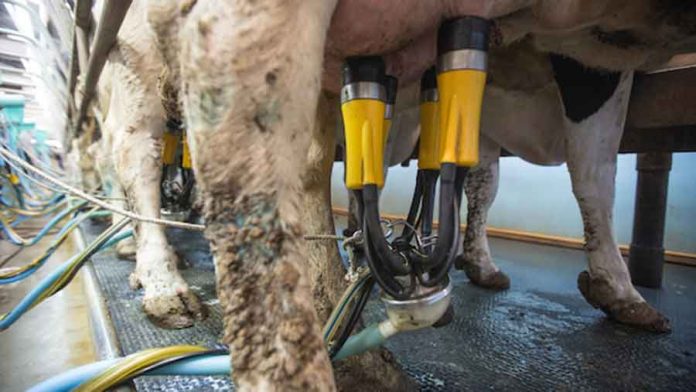With many milk contracts in both the UK and USA now rewarding farmers for higher butterfat production, understanding what influences its production and how to reduce it is key.
A holistic approach is required to correct milk fat depression (MFD) with good milk records fundamental.
That’s according to Dr Adam Lock, associate professor at Michigan State University’s department of Animal Science, who says knowing the precise value of ingredients going into the cow’s diet and reviewing feeding practices are other musts.
What causes MFD?
Unsaturated fatty acids are processed into saturated fat in the rumen. MFD occurs when pathways change during the ruminal biohydrogenisation of fatty acids and produce trans-10, cis-12 CLA.
Common causes for the production of this compound include excessive intake of unsaturated fatty acids, reduced rumen pH, or the cow’s diet may be too quickly fermentable (not enough forage and too high in rapidly fermentable grains) which causes faster rumen throughput.
It normally takes seven to 10 days for MFD to be seen in the bulk tank after a dietary or management change.
Young, fresh pasture is high risk because it contains high amounts of unsaturated fat and is low in fibre.
There is no single factor that leads to milk fat depression, which can make it harder to control and investigate.
Control should focus on balancing nutrition, environment, the cow’s physiological state and management.
Troubleshooting milk fat depression
Milk fat also varies throughout the season, typically dropping in the UK between April and August, so seasonality must be taken into account when troubleshooting a drop in fat production.
Key to this is being able to assess relevant data. Farmers should benchmark their three-year rolling averages for milk composition and compare like for like.
When bulk milk tank values go down, you need to consider if it is a part of seasonality you would be expecting or is it something else.
To assess this, compare the data to the same time last year. Compare month for month, like for like, and compare yourself against co-op averages. That will allow you to predict fat concentrations and manage expectations.
Ask yourself: Is it in a certain group of cows or ones where a certain diet is being fed and where am I on my seasonality curve?
Troubleshooting cow diets and management
Farmers seeking to boost milk components should focus on nutrition, with unsaturated fatty acid intake and diet fermentability primary issues to consider.
When formulating diets Dr Lock says farmers should not rely on “book values” for fatty acids because there is too much variation. Instead it is advisable to get products properly analysed.
While by-products are good value, farmers using them should also be wary of their variable fatty acids contents.
Rumen environment is critical. If rumen pH is high more unsaturated fat can often be included in the diet.
Increasing the amount of physically effective neutral detergent fibre (peNDF) in the diet can help maintain higher pH.
Feeding environment must also be considered, with research showing butterfat increasing the more times cows are fed.
Putting more more fresh food front of the cattle will help but once a day is satisfactory as long as the food is not heating up and is being pushed up regularly.
The important thing is to prevent cows eating large amounts in one go.
Maximising milk fat takes constant experimentation – if changes are not seen relatively quickly, within 10-14 days, then move on and make another change.
Tips for correcting milk fat depression (MFD) and feeding fats
- Get levels of fatty acids analysed in the diet, especially from by-product feeds
- Be aware of the high fat content of fresh pasture
- Reducing the fermentability of the diet helps. Feeding less wheat and more corn or barley helps slow the rate of rumen starch fermentation
- Changes in rumen pH is key to controlling milk fat. Use strategies to avoid low pH help to overcome low milk fat such as reducing diet fermentability and providing more effective fibre/buffering capacity
- Avoid “slug feeding” – feeding cows large meals in one go
- Avoid feeding fat supplements that contain steric acid – it’s low digestibility
- Fish oil can increase the risk of low milk fat if not fed properly because it contains more double bonds and therefore can potentially have more negative effects on rumen bacteria – so be careful.





